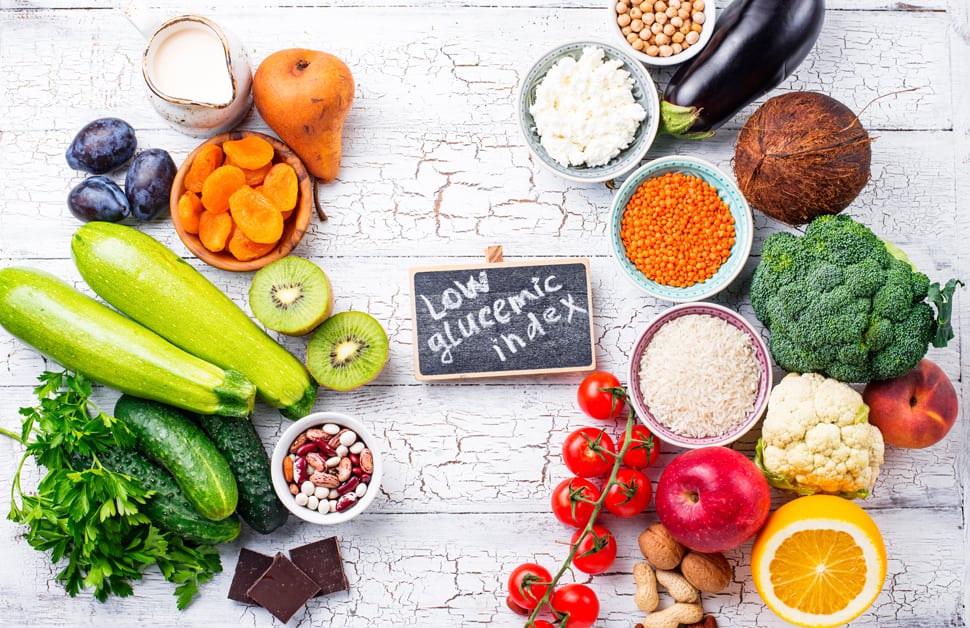Understand Low-Glycemic Index Foods
Glycemic index of a food item? It’s a measure of how fast the food makes blood sugar level rise. Low-glycemic index food = slow and steady rise in sugar level. Now that’s beneficial for those with joint pain and inflammation. So, this article is about understanding low-glycemic index food and how to pick them to get the best relief from knee pain.
What is the Glycemic Index?
Glycemic Index (GI) is a system that ranks how quickly your body turns carbohydrates from different types of food into glucose. This glucose is used for energy. This system uses a scale from 0-100, 100 being the highest.
High-GI foods are fast carbs, which break down into glucose quickly and raise your blood sugar levels rapidly. Low-GI foods, on the other hand, are complex carbs. They take longer for your body to absorb and break down, meaning your blood sugar levels rise slowly.
For joint pain, it’s better to choose low-GI foods such as whole grains, legumes, and most fruits and vegetables. These will keep your blood sugar levels steady, rather than spiking up after eating high-GI items. Steady blood sugar levels can help with knee pain relief, so it’s important to consider when choosing meals. High-GI foods can be useful in certain situations, e.g. for energy after exercise.
Benefits of Low-Glycemic Index Foods
Low-glycemic index (GI) foods are digested more slowly and cause lower increases in blood sugar. This is important for people with knee pain, since high blood sugar can lead to inflammation, which can result in joint discomfort. Low-GI foods help keep blood glucose levels steady, and they can even aid weight loss if eaten as part of a healthy diet.
Plus, regular consumption of low-GI meals may reduce the danger of type 2 diabetes and other metabolic diseases, lower LDL (“bad”) cholesterol and triglycerides, improve the body’s response to insulin, and decrease the risk of cardiovascular illness. Eating this way also eliminates unhealthy refined sugars from your diet – another factor in joint pain.
Low glycemic index food choices include:
- Nonstarchy veggies such as asparagus, broccoli, and spinach.
- Fruits like apples, oranges, and pears.
- Nuts like almonds.
- Legumes like beans and lentils.
- Whole grains like oats, quinoa, and barley.
- Greek yogurt.
- Lean meats like chicken breast or fish.
- Oils such as olive oil or avocado oil.
- Eggs.
- Teas like green tea or oolong tea.
By knowing what makes a food low glycemic index and adding these items to your diet, you can enjoy the multiple benefits of a low GI diet: increased energy throughout the day with fewer blood sugar spikes – and alleviate knee pain symptoms caused by inflammation.
Identify Low-Glycemic Index Foods
For knee pain relief, eating low-GI foods is awesome! Low GI foods have a lower Glycemic Index score and cause a gradual rise in blood sugar. But what are these low-GI foods that can help with knee pain? Let’s find out!
- Fruits such as oranges, apples, pears, peaches, and berries
- Vegetables such as broccoli, spinach, tomatoes, and carrots
- Whole grains such as oatmeal, quinoa, and brown rice
- Legumes such as lentils, black beans, and chickpeas
- Nuts and seeds such as almonds, walnuts, and pumpkin seeds
High-Glycemic Foods to Avoid
High-glycemic foods cause a rapid spike in blood sugar levels. This can lead to joint pain, such as knee pain. To prevent this, you should avoid these foods.
- White bread: Has an GI of 73. Contains little fiber and few nutrients.
- Corn flakes: GI of 79. Eating this can increase blood sugar levels, worsening knee pain.
- White rice: GI of 72. Nutritious, but limit your intake.
- Pretzels: GI of 83. Little nutrition, but huge impact on blood sugar levels. Consume sparingly.
- Chips: Potato chips are high-glycemic. Sudden rush of glucose into your bloodstream, worsening joint inflammation related to knee conditions.
Low-Glycemic Foods to Include
When it comes to knee pain and inflammation, low-Glycemic Index (GI) foods may be helpful. GI is how fast carbs break down, forming glucose in the gut and entering the bloodstream. Low GI foods take longer to digest, releasing energy slowly and keeping blood sugar levels even. Whereas high-GI foods cause a blood sugar spike, which can lead to inflammation and joint pain.
To protect against knee pain, try low-GI foods. Examples include:
- Whole grains: barley, wheatberries & oats
- Legumes: kidney beans & chickpeas
- Nuts & Seeds: almonds & sunflower seeds
- Dairy: natural yogurt & milk
- Low sugar fruits: apples, pears and plums
- Vegetables: Broccoli and mushrooms
Shopping Tips
For a healthy, active lifestyle, it is essential to eat the right foods – particularly if you’re experiencing knee pain. Low-glycemic index foods are a great choice. These foods have less glucose, which helps them break down more slowly and makes you feel fuller.
Here are the benefits of buying low-glycemic index foods and tips to make the process simpler:
Read Labels
Reading product labels is essential for finding low-glycemic index foods. The glycemic index (GI) measures how quickly the food raises your blood sugar when consumed. Low-GI foods cause a small change in your body’s blood sugar levels, so they can help relieve knee pain.
When choosing food, look for lower calories and carbs, and higher fiber, proteins, and healthy fats. Opt for whole grain or “whole grain-rich” products instead of refined grains for the best nutrients and stable blood sugar. Low GI carbs include quinoa, amaranth, faro, barley, bulgur wheat, oat groats/steel cut oats, lean beef or chicken, non-starchy veggies like broccoli and spinach, and many fruits like oranges or apples.
Avoid processed foods as they often have added sugars or artificial sweeteners, which can cause big blood sugar spikes. Scan ingredient lists to identify processed foods – if there’s more than one item on the label, it’s likely highly processed. Searching for “non-GMO” or “low glycemic load” terms can be helpful too.
Choose Whole Foods
It’s key to go for whole foods when shopping for low-GI items. Whole foods have less processing, with more natural vitamins, minerals, antioxidants, and fiber. Examples?
- Carrots
- Squash
- Onions
- Spinach
- Blueberries
- Apples
- Black beans
- Chickpeas
- Walnuts
- Almonds
- Cashews
- Brown rice
- Quinoa
- Fish
- Chicken
Whole foods provide essential nutrients for health. Unlike refined foods, they don’t cause blood sugar spikes. Plus, you can buy seasonal ingredients, saving money and helping the environment. For even lower GI, add herbs and spices for flavor.
Buy Organic When Possible
Organic food is a popular choice for people who want to care for their health. It’s grown without synthetic pesticides and fertilizers, reducing exposure to toxins. And it’s usually fresher, making it great for low-glycemic index items and knee pain relief.
Do some research on the producer when you buy organic food. Make sure it’s free of hormones and antibiotics. Stores often label organic produce, helping you buy with confidence.
Meal Planning
Meal planning is a key to lessening knee aches. Pick foods that are low on the glycemic index. These foods bring slow energy and can lessen soreness. Here are some tips to help you pick low-glycemic index foods for knee pain relief:
- Choose whole grains like brown rice, quinoa, or oats.
- Pick vegetables like carrots, spinach, and asparagus.
- Choose fruits such as apples, oranges, and pears.
- Opt for lean proteins like fish, chicken, and beans.
- Include healthy fats like avocados, nuts, and seeds.
Balance Your Plate
When planning meals with low glycemic index, balance is key. Aim for half your plate to be filled with non-starchy veggies like leafy greens, cucumbers and carrots.
The other quarter should have 1-2 servings of lean protein, such as eggs and fish.
Fill the remaining quarter with complex carbs like quinoa and oats. Add a side of healthy fats like olive oil or nuts.
Doing this can help reduce symptoms such as inflammation and stiffness. Plus, it may even reduce anxiety while experiencing chronic knee pain.
Focus on Protein and Fiber
When planning meals, focus on foods with a low-glycemic index (GI). Protein and fiber both have a GI of zero, which means they won’t spike your blood sugar. So, add more of these to your diet to reduce inflammation pain in your knees.
Lean cuts of meat, poultry, fish, egg whites, legumes, tempeh, tofu, nuts, seeds, Greek yogurt, cottage cheese, fish like salmon or trout, shellfish like prawns and crabs are all great sources of protein. Low in fat too!
Fiber also helps reduce inflammation. Include high-fiber foods like fruits and veggies, especially leafy greens, whole grains, quinoa, brown rice, flaxseed, and chia seeds. You can get fiber from legumes, nuts, and even popcorn. Baked goods with whole wheat flour are good too. Adults should aim for 25g of fiber per day for best relief from knee arthritis.
Introduce vitamins C & D, and Omega-3 fatty acids from fish oil supplements into your meals. This will give comprehensive relief from knee pain, and reduce other aches associated with arthritis.
Incorporate Healthy Fats
Incorporate healthy fats in your diet! They help reduce knee pain and inflammation. Fish, nuts, avocados and olive oil are all good. They give the body essential fatty acids that reduce inflammation and provide energy.
Include a variety of healthy fats in your meal plan. Try salmon or walnuts for dinner. An avocado or Greek yogurt snack is great too. Sprinkle roasted almonds and sunflower seeds over your oatmeal for breakfast. Get the full health benefits!
Preparing Low-Glycemic Index Meals
For reducing knee pain, it’s key to make meals from low-glycemic index ingredients. Low-glycemic foods are helpful as they balance blood sugar levels. This article will explain how to pick the best low-glycemic foods and create yummy and healthy dishes using them.
Choose Low-Glycemic Index Carbohydrates
For knee pain relief, pick food with a low-glycemic index. These carbs provide sustained energy and don’t cause a sudden spike in blood sugar. To regulate insulin levels, choose lentils, beans, split peas, oatmeal, barley, quinoa, spelt, farro, sweet potatoes, yams, buckwheat, multigrain breads and pastas.
Low-glycemic index fruits include apples, pears, strawberries, blueberries, oranges, peaches and grapefruits. Non-starchy veggies like spinach or kale also provide low glycemic values. These foods make you feel full longer and give you more nutrients. Drink plenty of water too, between meals.
Add Healthy Fats and Proteins
Low-glycemic index meals need healthy fats and proteins. These take more time for the body to digest, which helps control blood sugar and insulin levels. Use small amounts of heart-healthy oils like olive, canola, or vegetable oils. Unsaturated fats from nuts, seeds, or avocados work too. For dairy, choose milk, cheese, or yogurt. Legumes such as chickpeas, lentils, or black beans are great. Plus, eggs, poultry, and fish are options. Plant-based proteins like tofu are also good.
Eating a variety of foods gives you the nutrition you need, plus more pleasure. Avoid processed meats with high fat, like bacon, since they don’t give much nutrition.
Incorporate Low-Glycemic Index Fruits and Vegetables
Low-glycemic index fruits and vegetables are key for reducing knee pain. Berries, apples, oranges, kiwis, peppers, carrots, squash, sweet potatoes and greens like spinach and kale can add flavor and nutrition to meals. Legumes like beans, lentils or chickpeas are great for their protein content.
These foods also provide joint-healthy antioxidants, Omega-3 fatty acids from nuts and seeds and vitamin C from citrus fruits. They help the body to work optimally and aid healing in the joint capsule. Plus, complex carbs from most fruits and veggies give energy without the spikes in blood sugar from processed grains.
Frequently Asked Questions
Q: What is the glycemic index?
A: The glycemic index is a system that ranks carbohydrates based on how quickly and how high they raise blood sugar levels. Foods that are high on the glycemic index are digested quickly, causing a rapid increase in blood sugar levels. Low-glycemic index foods are digested more slowly, causing a more gradual rise in blood sugar levels.
Q: What are some examples of low-glycemic index foods?
A: Some examples of low-glycemic index foods include dairy products, whole grains, legumes, apples, oranges, strawberries, broccoli, cauliflower, spinach, and other vegetables. Fats and proteins are also low on the glycemic index.
Q: How can low-glycemic index foods help with knee pain?
A: Low-glycemic index foods can help reduce inflammation and keep blood sugar levels stable, which can help reduce knee pain. Eating a balanced diet that includes low-glycemic index foods can also help reduce overall inflammation in the body, which can help reduce knee pain.





